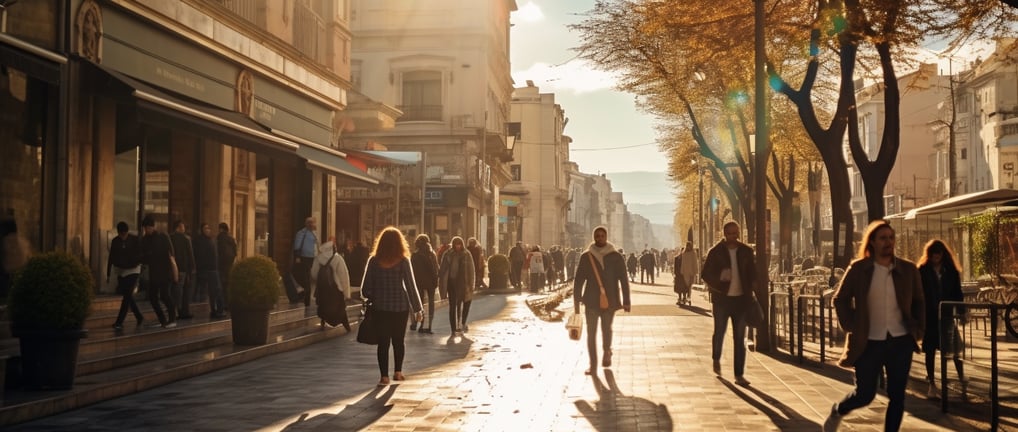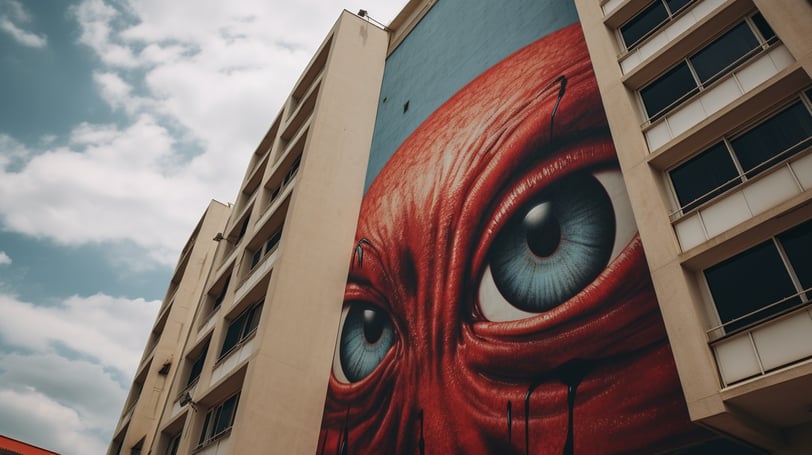The Colors of Tirana: A Cultural and Artistic Exploration
In the heart of Albania lies the vibrant capital city of Tirana, a place where colors come alive and weave together a rich tapestry of culture and art. From the historical influences to the modern artistic expressions, Tirana's colors tell a story that is waiting to be explored. Join us on a journey through the colorful streets of this fascinating city and discover the hidden meanings, the artistic expressions, and the cultural significance that make up the colors of Tirana.

One cannot fully comprehend the colors of Tirana without understanding the unique color palette that defines this city. From the vivid hues of red, blue, and yellow to the earthy tones of green, brown, and orange, Tirana's color palette is a reflection of its diverse history, architecture, and artistic soul.
The Influence of History on Tirana's Colors
Tirana's history has shaped its colors in profound ways. From the Ottoman Empire's rule to the communist era and the recent democratic transition, Tirana has seen a remarkable transformation. Each period of history has left its mark on the city's color palette, creating a vibrant tapestry of hues that tell a story of resilience and adaptation.
During the Ottoman Empire's rule, Tirana was influenced by the rich colors of the Orient. The city's architecture featured intricate patterns and vibrant shades of red, blue, and yellow, reflecting the opulence and grandeur of the empire. These colors symbolized power and authority, creating a sense of awe and majesty in the cityscape.
However, the communist era brought a dramatic shift in Tirana's color palette. The regime imposed a strict ideology that favored muted and monochromatic colors, reflecting the regime's desire for uniformity and conformity. The vibrant hues of the past were replaced with shades of gray, symbolizing the suppression of individuality and creativity.
With the fall of communism and the transition to democracy, Tirana experienced a rebirth of color. The city embraced its newfound freedom by reintroducing vibrant and expressive colors into its architecture and public spaces. The streets became a canvas for artistic expression, with colorful murals and street art adorning every corner. This explosion of color represented a celebration of individuality, diversity, and the city's newfound democratic spirit.
The Role of Art in Shaping Tirana's Color Identity
Art has always played a significant role in Tirana's color identity. The city is adorned with vibrant murals, street art, and sculptures that breathe life into its streets. Artists use colors to express their emotions, inspire change, and challenge the status quo, creating a dynamic cityscape that captivates locals and visitors alike.
One of the most iconic examples of art shaping Tirana's color identity is the Pyramid of Tirana. Originally built as a museum to honor the communist leader Enver Hoxha, the pyramid has become a symbol of artistic rebellion. Graffiti artists have transformed its once monochromatic facade into a kaleidoscope of colors, turning it into a living testament to the power of art to reclaim and redefine a space.
Another notable example is the Colorful Facades project, which aimed to revitalize Tirana's communist-era apartment buildings. Local artists were invited to paint the facades with vibrant colors, transforming the gray and dull buildings into a vibrant and lively neighborhood. This project not only added visual interest to the city but also brought communities together and fostered a sense of pride and ownership.
Furthermore, Tirana's art galleries and museums showcase a diverse range of artistic styles and mediums, each with its own unique color palette. From abstract paintings with bold and contrasting colors to intricate sculptures that play with light and shadow, these artistic expressions contribute to the city's vibrant and ever-evolving color identity.
In conclusion, Tirana's unique color palette is a testament to its rich history, artistic spirit, and ongoing transformation. The colors of the past, present, and future coexist in harmony, creating a visual symphony that reflects the city's resilience, creativity, and vibrant soul.
The Symbolism of Colors in Tirana's Architecture
Architecture in Tirana is a kaleidoscope of colors, each shade carrying its own symbolism and meaning. Let's dive deeper into the world of Tirana's architectural colors and decipher the messages they convey.
Tirana, the capital city of Albania, is known for its rich history, stunning landscapes, and vibrant culture. The city's architecture reflects this vibrancy, with buildings adorned in a myriad of colors that tell stories of hope, tranquility, and energy.
Decoding the Colors of Tirana's Buildings
Every building in Tirana holds a story, and its colors offer a glimpse into that narrative. Vibrant yellows symbolize hope and joy, representing the city's optimistic spirit and the resilience of its people. These sunny hues can be seen adorning the facades of residential buildings, filling the streets with a sense of warmth and positivity.
Deep blues, on the other hand, evoke a sense of calm and tranquility. These colors can be found in the architectural details of Tirana's historical landmarks, such as the Et'hem Bey Mosque and the Clock Tower. The use of blues in these structures creates a serene atmosphere, inviting visitors to pause and reflect in the midst of the bustling city.
Green, a color often associated with nature and growth, can be seen in the parks and gardens that dot Tirana's landscape. These green spaces provide a refreshing escape from the urban hustle and bustle, offering residents and visitors a chance to connect with nature and find solace in its beauty.
By understanding the meanings behind these colors, we can decipher the hidden messages that Tirana's buildings convey. The city's architecture becomes more than just a visual spectacle; it becomes a language, speaking to the emotions and aspirations of its inhabitants.
The Impact of Color on Tirana's Cityscape
Tirana's cityscape is a vivid canvas where colors merge and interact. From the bustling Skanderbeg Square with its brightly colored fountains to the charming streets of Blloku adorned with vibrant cafes and shops, color permeates every corner of the city, creating a sense of vibrancy and energy.
These vibrant colors not only add visual interest to the cityscape but also have a profound impact on the mood and atmosphere of Tirana. The use of bold and bright colors reflects the city's lively and dynamic character, inviting residents and visitors alike to embrace its energetic spirit.
Furthermore, the strategic use of colors in Tirana's architecture has the power to transform spaces and evoke specific emotions. Warm tones like reds and oranges can create a sense of excitement and passion, while cool tones like purples and greens can promote a feeling of relaxation and harmony.
As you explore Tirana's streets, you'll notice how the colors of the buildings interact with each other, creating a harmonious visual symphony. The juxtaposition of contrasting colors adds depth and dimension to the cityscape, making each corner a unique and captivating sight.
In conclusion, the symbolism of colors in Tirana's architecture goes beyond mere aesthetics. It tells stories, conveys emotions, and shapes the city's identity. The kaleidoscope of colors that adorn Tirana's buildings is a testament to the city's vibrant culture, rich history, and the spirit of its people.
Tirana's Street Art: A Riot of Colors

Walk through the neighborhoods of Tirana, and you'll witness a riot of colors in the form of street art. These vibrant murals, graffitis, and installations not only add beauty to the city but also serve as a powerful reflection of Tirana's urban aesthetics.
The Role of Street Art in Tirana's Urban Aesthetics
Street art has become an integral part of Tirana's urban aesthetics. Artists use colors to make political statements, reflect on social issues, and celebrate the city's diversity. From thought-provoking messages to whimsical characters, Tirana's street art scene is a testament to the city's creative spirit.
How Street Art Reflects Tirana's Cultural Diversity
Tirana is a melting pot of cultures, and street art serves as a visual representation of this diversity. Artists draw inspiration from Albania's rich heritage and the multicultural fabric of the city, infusing their artwork with a variety of colors and influences.
The Colors of Tirana's Festivals and Celebrations
Throughout the year, Tirana bursts with color as festivals and celebrations take center stage. These vibrant events showcase the city's cultural heritage and provide an opportunity for locals and tourists to immerse themselves in a kaleidoscope of colors.
The Significance of Colors in Traditional Festivals
In traditional festivals, colors play a vital role in conveying messages and symbolizing specific cultural elements. From the vibrant reds and golds of folk costumes to the colorful flags and banners, each hue tells a story and represents a deeper cultural significance.
The Vibrancy of Tirana's Celebrations Through Colors
When it comes to celebrations, Tirana knows how to make a statement with colors. Whether it's the colorful fireworks lighting up the sky during New Year's Eve or the vibrant parades that take over the city's streets, Tirana's celebrations are a testament to its colorful spirit and zest for life.
The Future of Color in Tirana's Cultural and Artistic Landscape
As Tirana continues to evolve, so too does its color palette. The future holds exciting possibilities for the city's cultural and artistic landscape as new trends emerge and old traditions intertwine with fresh perspectives.
The Evolution of Color Use in Tirana's Art Scene
The art scene in Tirana is in a constant state of evolution. Artists experiment with new color combinations, techniques, and mediums, pushing boundaries and challenging the norms. As a result, Tirana's art scene continues to evolve, offering new perspectives and captivating experiences for art enthusiasts.
Predicting Color Trends in Tirana's Future Urban Design
As Tirana undergoes urban development and design, the colors that shape its landscape also change. Architects and designers envision new color schemes and trends that reflect the city's aspirations and aspirations of the future. From sustainable buildings adorned with greenery to vibrant public spaces, Tirana's future promises a harmonious integration of colors and design.
Conclusion
The colors of Tirana are not merely decorative elements; they are the threads that weave together the city's cultural and artistic identity. Whether expressed through historical buildings, vibrant street art, or colorful celebrations, Tirana's colors reflect the soul of a city that continues to grow and evolve. So, venture into the vibrant streets of Tirana, let the colors guide you, and immerse yourself in the captivating beauty of this cultural and artistic haven. Discover the colors of Tirana and unlock the stories that lie beneath the surface. Your journey awaits!